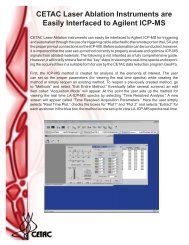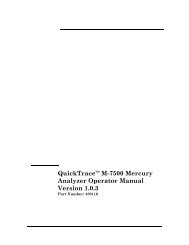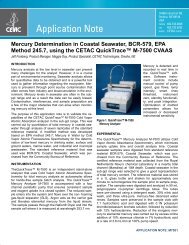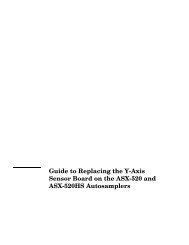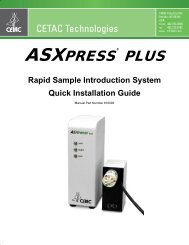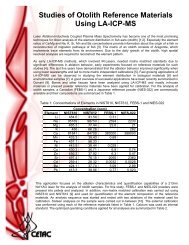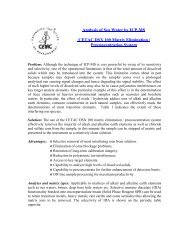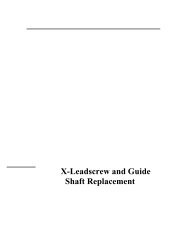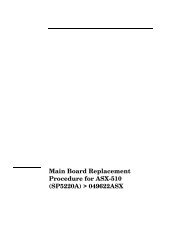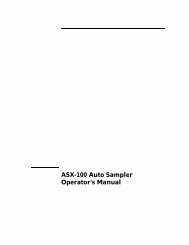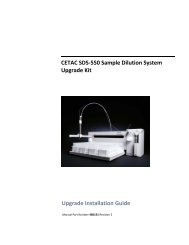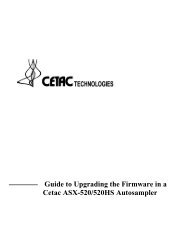Marin-5 Operator's Manual - CETAC Technologies
Marin-5 Operator's Manual - CETAC Technologies
Marin-5 Operator's Manual - CETAC Technologies
You also want an ePaper? Increase the reach of your titles
YUMPU automatically turns print PDFs into web optimized ePapers that Google loves.
<strong>Marin</strong>-5 Enhanced<br />
Nebulizer System<br />
Operator’s <strong>Manual</strong>
Product Warranty Statement<br />
SD Acquisition, Inc., DBA <strong>CETAC</strong> <strong>Technologies</strong> (“<strong>CETAC</strong>”), warrants<br />
any <strong>CETAC</strong> unit manufactured or supplied by <strong>CETAC</strong> for a period<br />
beginning on the date of shipment and ending on the sooner to occur of:<br />
(a) the date that is twelve (12) months from the date of installation, or<br />
(b) the date that is thirteen (13) months from the date of shipment.<br />
Units found in the reasonable judgement of <strong>CETAC</strong> to be defective in<br />
material or workmanship will be repaired or replaced by <strong>CETAC</strong><br />
without charge for parts and labor. <strong>CETAC</strong> reserves the right to change<br />
or improve the design of any unit without assuming any obligation to<br />
modify any unit previously manufactured.<br />
This warranty does not cover any unit that has been subject to misuse,<br />
neglect, negligence, or accident. The warranty does not apply to any<br />
damage to the unit that is the result of improper installation or<br />
maintenance, or to any unit that has been operated or maintained in<br />
any way contrary to the instructions specified in the <strong>CETAC</strong> operator’s<br />
manual. Operation of the <strong>CETAC</strong> unit inside a laboratory fume hood is<br />
contra-indicated and will void the warranty. Any attempt to repair or<br />
alter any <strong>CETAC</strong> unit by anyone other than by <strong>CETAC</strong> authorized<br />
personnel or agents will void this warranty. If any non-<strong>CETAC</strong><br />
component is installed in the <strong>CETAC</strong> manufactured unit without the<br />
approval of <strong>CETAC</strong>, the warranty will be voided. In addition, this<br />
warranty does not extend to repairs made necessary by the use of parts,<br />
accessories or fluids which are either incompatible with the unit or<br />
adversely affect its operation, performance or durability. <strong>CETAC</strong>’S<br />
obligation under this warranty is strictly and exclusively limited to<br />
repair or replacement of defective <strong>CETAC</strong> parts, and no claim of breach<br />
of warranty shall be cause for cancellation or recission of the contract of<br />
sale of any unit.<br />
The foregoing express warranty is in lieu of all other warranties,<br />
expressed or implied, including warranties of merchantability and<br />
fitness for a particular purpose. <strong>CETAC</strong> shall not be bound by any<br />
representations or statements on the part of its employees or agents<br />
whether oral or in writing and including any made in catalogues and<br />
other promotional material including technical details and<br />
specifications except where such representations and statements are<br />
expressly made part of this contract. <strong>CETAC</strong> assumes no responsibility<br />
for incidental, consequential or other damages, even if advised of such a<br />
possibility, including but not limited to loss or damage of property, loss<br />
of revenue, loss of use of the unit, loss of time, or inconvenience.<br />
<strong>CETAC</strong>’s liability on any claim for loss or damage arising out of the<br />
sale, resale or use of any of its products shall in no event exceed the<br />
selling price of the unit.
Purchaser shall indemnify <strong>CETAC</strong> against any claim or liability which<br />
may be asserted as relates to the following: (i) the use to which any<br />
product supplied hereunder is put infringes the patent, copyright or<br />
other intellectual property rights of any third party; or (ii) any liability<br />
resulting from the failure by Purchaser to observe the terms of this<br />
Warranty.<br />
Returned Product Procedures<br />
Claims for shipment damage (evident or concealed) must be filed with<br />
the carrier by the buyer. <strong>CETAC</strong> must be notified within ninety (90)<br />
days of shipment of incorrect materials. No product may be returned,<br />
whether in warranty or out of warranty, without first obtaining<br />
approval from <strong>CETAC</strong>. No replacements will be provided nor repairs<br />
made for products returned without such approval. Any returned<br />
product must be accompanied by a return authorization number. The<br />
expense of returning the unit to <strong>CETAC</strong> for service will be paid by the<br />
buyer. The status of any product returned later than thirty (30) days<br />
after issuance of a return authorization number will be subject to<br />
review. Shipment of repaired products will generally be made fortyeight<br />
(48) hours after the receipt.<br />
Products may not be returned which are contaminated by radioactive<br />
materials, infectious agents, or other materials constituting health<br />
hazards to <strong>CETAC</strong> employees.<br />
Returned Product Warranty Determination<br />
After <strong>CETAC</strong>’s examination, warranty or out of warranty status will be<br />
determined. If a warranted defect exists, the product will be repaired at<br />
no charge and shipped prepaid back to the buyer. If the buyer desires<br />
an air freight return, the product will be shipped collect. Warranty<br />
repairs do not extend the original warranty period.<br />
If an out of warranty defect exists, the buyer shall be notified of the<br />
repair cost. At such time the buyer must issue a valid purchase order to<br />
cover the cost of repair and freight, or authorize the products to be<br />
shipped back as is, at the buyer’s expense. Failure to obtain a purchase<br />
order number approval within fifteen (15) days of notification will result<br />
in the products being returned as is, at the buyers expense.
COPYRIGHT<br />
Copyright SD Acquisition, Inc.,<br />
DBA <strong>CETAC</strong> <strong>Technologies</strong><br />
480160 Version 1.2, March, 2010<br />
REPRODUCTION<br />
All rights reserved. Reproduction or<br />
transmission of this document in whole or<br />
in part, and by any means without the<br />
express written consent of the copyright<br />
owner or authorized agent is prohibited.<br />
Requests for additional copies of this, or<br />
any other <strong>CETAC</strong> publication, can be filled<br />
by contacting an authorized distributor or<br />
<strong>CETAC</strong> <strong>Technologies</strong><br />
Customer Service & Support<br />
14306 Industrial Road<br />
Omaha, Nebraska 68144, USA<br />
Phone (800) 369-2822 (USA only)<br />
Phone (402) 733-2829<br />
Fax (402) 733-1932<br />
E-mail custserv@cetac.com<br />
DISCLOSURE<br />
This document contains <strong>CETAC</strong><br />
proprietary data and is provided solely to<br />
its customers for their express benefit of<br />
safe, efficient operation and maintenance<br />
of the product described herein. Use or<br />
disclosure of <strong>CETAC</strong> proprietary data for<br />
the purpose of manufacture or<br />
reproduction of the item described herein,<br />
or any similar item, is prohibited, and<br />
delivery of this document shall not<br />
constitute any license or implied<br />
authorization to do so.<br />
SAFETY<br />
Instruments, accessories, components or<br />
other associated materials may not be<br />
returned to <strong>CETAC</strong> <strong>Technologies</strong> if<br />
contaminated with biohazard or<br />
radioactive materials, infectious agents, or<br />
any other materials and/or conditions that<br />
could constitute a health or injury hazard<br />
to <strong>CETAC</strong> employees. Call Customer<br />
Service and Support if there is any<br />
question or doubt relative to<br />
decontamination<br />
requirements.<br />
CAUTION and WARNING statements, as<br />
applied in this document, shall be<br />
interpreted consistent with the following<br />
context: CAUTION applies only to<br />
potential property damage conditions;<br />
WARNING applies to potential personal<br />
injury conditions, in combination with or<br />
exclusive of potential property damage.<br />
All user-serviceable components are<br />
specifically identified in this document as<br />
such; the balance shall be assumed to<br />
require the expertise of a factory service<br />
technician/engineer for adjustment, repair,<br />
replacement, modification, etc. Others not<br />
so qualified and performing these actions<br />
shall do so at their own risk.<br />
Furthermore, never operate the<br />
instrument without first reading and<br />
understanding the Aridus Desolvating<br />
Sample Introduction System Operator’s<br />
<strong>Manual</strong> and ensuring that it is operated<br />
safely and properly.<br />
WARNING<br />
REVISIONS<br />
<strong>CETAC</strong> <strong>Technologies</strong> strives to provide the<br />
scientific community with an unparalleled<br />
combination of effective technology and<br />
continuing value. Modular upgrades for<br />
existing instruments will continue to be a<br />
prime consideration as designs progress.<br />
<strong>CETAC</strong> <strong>Technologies</strong> reserves the right to<br />
revise this document and/or improve<br />
products described herein at any time<br />
without notice or obligation. Warranty<br />
registration entitles the named owner<br />
exclusively to manual change pages/new<br />
editions as they are published.<br />
ORIGINAL PACKAGING<br />
Retain original factory packaging for<br />
moves and factory return shipments.<br />
Shipping in anything other than the<br />
original fitted foam and container can<br />
result in incidental damage from which<br />
the purchaser will not be protected under<br />
warranty.<br />
Under all conditions the user must observe safe laboratory<br />
procedures during the operation of this product.
FEDERAL COMMUNICATIONS<br />
COMMISSION (FCC) NOTICE<br />
This equipment has been tested and found<br />
to comply with the limits for a Class A<br />
digital device, pursuant to Part 15 of the<br />
FCC Rules. These limits are designed to<br />
provide reasonable protection against<br />
harmful interference in a commercial<br />
installation.<br />
This equipment generates, uses, and can<br />
radiate radio frequency energy and, if not<br />
installed and used in accordance with the<br />
instructions, may cause harmful<br />
interference to radio communications.<br />
Operation of this equipment in a<br />
residential environment is likely to cause<br />
harmful interference, in which case the<br />
user will be required to correct the<br />
interference at his or her own expense.<br />
MODIFICATIONS<br />
The FCC requires the user to be notified<br />
that any changes or modifications made to<br />
this device that are not expressly approved<br />
by <strong>CETAC</strong> <strong>Technologies</strong> may void the<br />
user's authority to operate the equipment.<br />
CANADIAN NOTICE<br />
This digital apparatus does not exceed the<br />
Class A limits for radio noise emissions<br />
from digital apparatus as set out in the<br />
interference-causing equipment standard<br />
entitled "Digital Apparatus." ICES-001 of<br />
the Department of Communications.<br />
AVIS CANADIEN<br />
Cet appareil numerique respecte les<br />
limites de bruits radioelectriques<br />
applicables aux appareils numeriques de<br />
Classe A prescrites dans la norme sur le<br />
materiel brouilleur: "Appareils<br />
Numeriques," NMB-001 edictee par le<br />
ministre des Communications.<br />
POWER CORD SET REQUIREMENTS<br />
The power cord set supplied with your<br />
instrument meets the requirements of the<br />
country where you purchased the<br />
instrument.<br />
If you use the instrument in another<br />
country, you must use a power cord set<br />
that meets the requirements of that<br />
country.<br />
CABLES<br />
Connections to this device must be made<br />
with shielded cables with metallic<br />
RFI/EMI connector hoods to maintain<br />
compliance with FCC Rules and<br />
Regulations.<br />
AD-1
Operator’s <strong>Manual</strong> Addendum<br />
Notices and Compliance Declarations<br />
WARNING<br />
This equipment is designed for connection to a grounded (earthed) outlet. The<br />
grounding type plug is an important safety feature. To reduce the risk of<br />
electrical shock or damage to the instrument, do not disable this feature.<br />
CAUTION<br />
To reduce the risk of fire hazard and electrical shock, do not expose the unit to rain or<br />
humidity. To reduce the risk of electrical shock, do not open the cabinet. All maintenance<br />
is to be performed by an Authorized <strong>CETAC</strong> Service Provider.<br />
Protection provided by the equipment may be impaired if the equipment is used in a<br />
manner not specified by the manufacturer.<br />
CLEANING INSTRUCTIONS<br />
To clean the exterior surfaces of the instrument, complete the following steps:<br />
1 Shut down and unplug the instrument. 3 Repeat step 2, using a towel dampened<br />
with clear water.<br />
2 Wipe the instrument exterior surfaces<br />
only using a towel dampened with a<br />
lab-grade cleaning agent.<br />
4 Dry the instrument exterior using a dry<br />
towel.<br />
WARNING<br />
Do not allow any liquid to enter the instrument cabinet, or come into contact<br />
with any electrical components. The instrument must be thoroughly dry before<br />
you reconnect power, or turn the instrument on.<br />
COOLING FAN OBSTRUCTION<br />
The instrument cooling fan(s) shall remain unobstructed at all times. Do not operate the<br />
instrument if the cooling fan(s) are blocked or obstructed in any manner.<br />
ENVIRONMENTAL<br />
Operating Temperature: 10° to 30°C<br />
Relative Humidity 0% to 90%
Operator’s <strong>Manual</strong> Addendum<br />
Notices and Compliance Declarations<br />
AVERTISSEMENT<br />
POUR UNE PROTECTION CONTINUÉ<br />
CONTRE LES RISQUES D’INCENDIE,<br />
REMPLACER UNIQUEMENT PAR DES<br />
FUSIBLES DE MÊME TYPE ET<br />
AMPÈRAGE.<br />
AVERTISSEMENT<br />
TOUT CONTACT AVEC LES HAUTES<br />
TENSIONS PEUT ENTRAINER LA MORT<br />
OU DES BLESSURES SÉVÈRES. CE<br />
PANNEAU NE DOIT ÊTRE ENLEVE QUE<br />
PAR UN RÉPARATEUR QUALIFIÉ.<br />
AVERTISSEMENT<br />
NE PAS GLISSER LA MAIN SOUS OU DERIERE LES<br />
ECRANS THERMIQUES DU FOUR. GARDER LA<br />
PORTE D'ACCES AU DEVANT DU BOITIER BIEN<br />
FERMEE POUR ASSURER LA PROTECTION CONTRE<br />
LES BRULURES<br />
AVERTISSEMENT<br />
TOUT CONTACT AVEC LES HAUTES<br />
TENSIONS PEUT ENTRAINER LA MORT<br />
OU DES BLESSURES SÉVÈRES. CE<br />
PANNEAU NE DOIT ÊTRE ENLEVE QUE<br />
PAR UN RÉPARATEUR QUALIFIÉ.<br />
AVERTISSEMENT<br />
TOUT CONTACT AVEC LES HAUTES<br />
TENSIONS PEUT ENTRAINER LA MORT<br />
OU DES BLESSURES SÉVÈRES. CE<br />
PANNEAU NE DOIT ÊTRE ENLEVE QUE<br />
PAR UN RÉPARATEUR QUALIFIÉ.
Operator’s <strong>Manual</strong> Addendum<br />
Notices and Compliance Declarations<br />
OUVRIR LE COUVERCLE ET LAISSER<br />
REFROIDIR 5 MINUTES AVANT DE<br />
TOUCHER LA VERRERIE OU TOUTE<br />
SURFACE MÉTALLIQUE INTÉRIEURE.<br />
AVERTISSEMENT<br />
TOUT CONTACT AVEC LES HAUTES<br />
TENSIONS PEUT ENTRAINER LA MORT<br />
OU DES BLESSURES SÉVÈRES. CE<br />
PANNEAU NE DOIT ÊTRE ENLEVE QUE<br />
PAR UN RÉPARATEUR QUALIFIÉ.<br />
WARNING<br />
HIGH LEAKAGE CURRENT -<br />
ENSURE PROPER GROUNDING<br />
AVERTISSEMENT<br />
COURANT DE FUITE ÉLEVÉ — FORNIR<br />
UNE MISE À LA TERRE EFFICACE.<br />
AVERTISSEMENT<br />
POUR LA PROTECTION PERMANENTE<br />
CONTRE UN CHOC ÉLECTRIQUE, UNE<br />
BRÛLURE DES YEUX (RADIATION UV)<br />
OU DE LA PEAU, LAISSER LE<br />
COUVERCLE HERMÉTIQUEMENT<br />
FERMÉ LORSQUE L’APPAREIL EST SOUS<br />
TENSION.<br />
LAISSER REFROIDIR 5 MINUTES<br />
(APPAREIL ÉTEINT) AVANT D’ENLEVER<br />
LE COUVERCLE.<br />
PANNEAU NE DOIT ÊTRE ENLEVE QUE<br />
PAR UN RÉPARATEUR QUALIFIÉ.<br />
AVERTISSEMENT<br />
COURANT DE FUITE ÉLEVÉ — FORNIR UNE MISE À<br />
LA TERRE EFFICACE.<br />
WARNING<br />
HIGH LEAKAGE CURRENT -<br />
ENSURE PROPER GROUNDING<br />
AVERTISSEMENT<br />
SURFACES CHAUDES, LAISSER LE<br />
COUVERCLE HERMÉTIQUEMENT<br />
FERMÉ.<br />
POUR ACCÉDER, METTRE LA<br />
TEMPÉRATURE DU FOUR À ZÉRO,<br />
AD-4
Operator’s <strong>Manual</strong> Addendum<br />
Notices and Compliance Declarations<br />
Attention – Allow the <strong>Marin</strong>-5 to cool for 30<br />
minutes.<br />
Attention – refer to the manual. This symbol<br />
indicates that information about usage of a<br />
feature is contained in the manual.<br />
WARNING<br />
If the <strong>Marin</strong>-5 is used in a manner not specified by <strong>CETAC</strong><br />
<strong>Technologies</strong>, the protection provided the equipment may be impaired.<br />
WARNING<br />
The power switch on the rear panel is not the mains disconnect.<br />
Mains disconnect is accomplished by disconnecting the detachable<br />
power supply cord at the appliance coupler or at the mains plug.<br />
Ensure the power cord is easily accessible and removable, in the event<br />
of an emergency, which requires immediate disconnection.<br />
AD-5
Do not dispose in domestic household waste.<br />
The affixed label indicates that you must not<br />
discard this electrical/electronic product in<br />
domestic household waste, in compliance with<br />
the European Waste Electrical and Electronic<br />
Equipment Directive (WEEE, 2002/96/EC).<br />
For instructions on how to return end-of-life<br />
equipment, producer-supplied electrical<br />
accessories, or auxiliary items for proper<br />
disposal please contact the supplier or importer.<br />
In the event a supplier cannot be reached,<br />
contact <strong>CETAC</strong> <strong>Technologies</strong> customer service<br />
department at 1 (800) 369 2822 (USA only) or<br />
custserv@cetac.com.<br />
The CE mark is a registered trademark of the<br />
European Community. This CE mark shows that<br />
the product complies with all the relevant<br />
European Legal Directives.<br />
AD-6
Table of Contents
<strong>Marin</strong>-5 Operator’s <strong>Manual</strong><br />
Contents<br />
Table of Contents<br />
Preface<br />
Who Should Read This Book<br />
How to Use This Book<br />
Conventions Used in This Book<br />
Instructions<br />
Terminology<br />
Notes<br />
Cautions<br />
Warnings<br />
Where to Go for More Information<br />
xii<br />
xii<br />
xii<br />
xiii<br />
xiii<br />
xiv<br />
xv<br />
xv<br />
xv<br />
xvi<br />
1 Introduction 1-2<br />
<strong>Marin</strong>-5 System Overview 1-3<br />
2 Preparing for Installation 2-2<br />
Unpacking the <strong>Marin</strong>-5 2-2<br />
<strong>Marin</strong>-5 Packaging 2-2<br />
Choosing a Location 2-3<br />
Space Requirements 2-3<br />
Power Requirements 2-3<br />
viii
<strong>Marin</strong>-5 Operator’s <strong>Manual</strong><br />
Contents<br />
ICP-AES/ICP-MS Requirements 2-4<br />
Gas Requirements 2-4<br />
3 Installing the <strong>Marin</strong>-5 3-2<br />
Establishing External Connections 3-2<br />
<strong>Marin</strong>-5 Voltage Selection 3-2<br />
Connecting the <strong>Marin</strong>-5 to the Power Source 3-3<br />
Installing the <strong>Marin</strong>-5 Spray Chamber/<br />
Glassware Assembly 3-4<br />
Connecting the <strong>Marin</strong>-5 to the ICP-AES or ICP-MS 3-8<br />
Connecting the Nebulizer 3-10<br />
Nebulizer Liquid Uptake Line 3-11<br />
Connecting the <strong>Marin</strong>-5 Drain Tubing 3-12<br />
4 Verifying Installation 4-2<br />
Initial Operating Procedure 4-2<br />
ICP-AES Operation 4-3<br />
ICP-AES Optimization 4-4<br />
ICP-AES/<strong>Marin</strong>-5 Optimization Procedure 4-4<br />
ICP-MS Operation 4-4<br />
ICP-MS Optimization 4-5<br />
ix
<strong>Marin</strong>-5 Operator’s <strong>Manual</strong><br />
Contents<br />
ICP-MS/<strong>Marin</strong>-5 Optimization Procedure 4-5<br />
Introduction of Organic Solvents 4-6<br />
Additional <strong>Marin</strong>-5 Operating Items 4-7<br />
Nebulizer Port Adapter 4-7<br />
Tee Assembly for Sample Out Line 4-7<br />
5 Using the <strong>Marin</strong>-5 5-2<br />
Establishing Optimal Conditions 5-2<br />
Establishing the Laboratory Environment 5-2<br />
Replacing <strong>Marin</strong>-5 Components 5-3<br />
Startup Procedure 5-4<br />
Shutdown Procedure 5-4<br />
Temperature Controller Operation 5-5<br />
6 Maintaining the <strong>Marin</strong>-5 6-2<br />
Cleaning the <strong>Marin</strong>-5 6-2<br />
Daily External Cleaning 6-2<br />
Daily Internal Cleaning 6-3<br />
Maintaining the Concentric Nebulizer 6-4<br />
Main Fuse Replacement 6-4<br />
Rinse Procedure for the <strong>Marin</strong>-5 Glassware 6-5<br />
x
<strong>Marin</strong>-5 Operator’s <strong>Manual</strong><br />
Contents<br />
Rinse Procedure for the <strong>Marin</strong>-5 Condenser 6-8<br />
Replacement of the Drain Pump Tubing 6-9<br />
Replacement of Broken Spray Chamber/<br />
Glassware Assembly 6-10<br />
7 Troubleshooting the <strong>Marin</strong>-5 7-2<br />
Temperature Controller Problems 7-2<br />
Solution Drainage Problems 7-3<br />
Nebulizer/Plasma Problems 7-3<br />
Plasma Problems 7-5<br />
8 Specifications 8-1<br />
xi
Preface
<strong>Marin</strong>-5 Operator’s <strong>Manual</strong><br />
Preface<br />
Preface<br />
The <strong>Marin</strong>-5 Operator’s <strong>Manual</strong> explains the procedures for installing,<br />
using, and maintaining the <strong>CETAC</strong> <strong>Marin</strong>-5 Enhanced Nebulizer<br />
System. It also provides information about troubleshooting <strong>Marin</strong>-5<br />
problems and describes the design of the system.<br />
Who Should Read This Book<br />
The primary audience for the <strong>Marin</strong>-5 Operator’s <strong>Manual</strong> consists of<br />
analytical chemists and lab technicians. To use this manual effectively,<br />
you should have a strong knowledge of chemistry, a basic knowledge of<br />
electronic sampling equipment, at least a beginning level of computer<br />
experience, and working knowledge of an inductively coupled plasma<br />
atomic emission spectrometer (ICP-AES) and/or an inductively coupled<br />
plasma mass spectrometer (ICP-MS).<br />
How to Use This Book<br />
The <strong>Marin</strong>-5 Operator’s <strong>Manual</strong> contains eight chapters. You should<br />
read the chapters sequentially the first time. Thereafter, refer to the<br />
chapters separately as needed.<br />
The <strong>Marin</strong>-5 Operator’s <strong>Manual</strong> contains the following chapters:<br />
Chapter 1, “Introduction,” provides you with an overview of the<br />
<strong>Marin</strong>-5 function and design.<br />
Chapter 2, “Preparing for Installation,” discusses space, power, and<br />
gas requirements that must be met before the <strong>Marin</strong>-5 is installed. It<br />
also provides instructions for unpacking the instrument and ICP-AES<br />
and/or ICP-MS requirements.<br />
xii
<strong>Marin</strong>-5 Operator’s <strong>Manual</strong><br />
Preface<br />
Chapter 3, “Installing the <strong>Marin</strong>-5,” provides step-by-step<br />
procedures for installing the <strong>Marin</strong>-5 and connecting it to the analytical<br />
instrument.<br />
Chapter 4, “Verifying Installation,” explains initial operation of the<br />
<strong>Marin</strong>-5, ICP-AES and ICP-MS operation, and system optimization.<br />
Chapter 5, “Using the <strong>Marin</strong>-5,” describes the tasks you perform<br />
during daily operation of the <strong>Marin</strong>-5.<br />
Chapter 6, “Maintaining the <strong>Marin</strong>-5,” explains daily, weekly, and<br />
periodic maintenance tasks.<br />
Chapter 7, “Troubleshooting the <strong>Marin</strong>-5,” describes how to<br />
diagnose and correct minor <strong>Marin</strong>-5 and ICP-AES or ICP-MS problems.<br />
Chapter 8, “Specifications,” lists important <strong>Marin</strong>-5 technical details<br />
such as power requirements, dimensions and weight.<br />
Conventions Used in This Book<br />
This book uses certain conventions to distinguish different types of<br />
information easily. This section describes these conventions.<br />
Instructions<br />
All step-by-step instructions are numbered and in bold type, as in the<br />
following example.<br />
1 Mount the sample probe assembly on the cover...<br />
Many numbered instructions are followed by more detailed<br />
explanations.<br />
xiii
<strong>Marin</strong>-5 Operator’s <strong>Manual</strong><br />
Preface<br />
Terminology<br />
This manual frequently uses the following terms:<br />
<strong>Marin</strong>-5<br />
ICP-AES<br />
ICP-MS<br />
Hz<br />
ID<br />
OD<br />
LED<br />
PEEK<br />
PFA<br />
PTFE<br />
PSI<br />
PVC<br />
Trademarks<br />
Enhanced Nebulizer System.<br />
An inductively coupled plasma atomic emission<br />
spectrometer.<br />
An inductively coupled plasma mass spectrometer.<br />
Hertz.<br />
Inside diameter.<br />
Outside diameter.<br />
Light-emitting diode.<br />
Polyetheretherketone.<br />
Perfluoroalkoxy<br />
Polytetrafluoroethylene.<br />
Pounds per square inch.<br />
Polyvinyl chloride.<br />
Teflon ® and Tefzel ® are registered trademarks of E.I.<br />
du Pont de Nemours.<br />
Tygon® is a trademark of Saint-Gobain Performance<br />
Plastics.<br />
VAC<br />
VDC<br />
Volts alternating current.<br />
Volts direct current<br />
xiv
<strong>Marin</strong>-5 Operator’s <strong>Manual</strong><br />
Preface<br />
Notes<br />
Notes contain a reminder about the effect of particular actions. Notes<br />
are indicated as follows:<br />
Note:<br />
This example shows how a note is displayed.<br />
Cautions<br />
Cautions indicate situations that require immediate attention to<br />
prevent harm to the <strong>Marin</strong>-5 Enhanced Nebulizer System. Cautions are<br />
indicated as follows:<br />
CAUTION<br />
This example shows how a caution is displayed.<br />
Warnings<br />
Warnings indicate situations that could cause bodily harm. Warnings<br />
are indicated as follows:<br />
WARNING<br />
This example shows how a warning is displayed.<br />
xv
<strong>Marin</strong>-5 Operator’s <strong>Manual</strong><br />
Preface<br />
Where to Go for More Information<br />
In addition to the <strong>Marin</strong>-5 Operator’s <strong>Manual</strong>, you can refer to the<br />
following resources:<br />
• Software and hardware manuals for the ICP-AES or ICP-MS<br />
instrument you are using.<br />
• <strong>CETAC</strong> <strong>Technologies</strong> Customer Service and Support:<br />
1 (800) 369-2822 (USA only)<br />
1 (402) 733-2829<br />
1 (402) 733-1932 (Fax)<br />
custserv@cetac.com<br />
xvi
1<br />
Introduction
<strong>Marin</strong>-5 Operator’s <strong>Manual</strong><br />
Introduction<br />
Introduction<br />
The <strong>CETAC</strong> <strong>Marin</strong>-5 Enhanced Nebulizer System is designed primarily<br />
for ICP-AES and ICP-MS. The <strong>Marin</strong>-5 consists of a pneumatic<br />
nebulizer, a specialized heated spray chamber, and a dedicated<br />
desolvation apparatus.<br />
Sensitivity is improved with the <strong>Marin</strong>-5 by increasing analyte<br />
transport efficiency and reducing solvent loading to the plasma.<br />
Functionally, liquid sample is pumped or self-aspirated to a pneumatic<br />
nebulizer at an uptake rate of ≤ 0.5 mL/min and an argon nebulizer gas<br />
flow rate of 0.5 to 1.1 L/min. The nebulizer is inserted into a heated<br />
spray chamber to convert a higher percentage of the liquid into an<br />
aerosol. The spray chamber is connected to a desolvation system to<br />
condense most of the liquid in the aerosol and maintain plasma<br />
stability. A built-in three-channel drain pump removes the condensed<br />
sample solvent to waste. Dried sample particles then continue in the<br />
nebulizer gas flow to the plasma, resulting in emitted analyte radiation<br />
(ICP-AES) or analyte ions (ICP-MS).<br />
The nebulizer, spray chamber, and desolvation system are protected by<br />
a secure lid, with access to the nebulizer via a front door. An external<br />
view of the <strong>Marin</strong>-5 is shown in Figure 1-1.<br />
1–2
<strong>Marin</strong>-5 Operator’s <strong>Manual</strong><br />
Introduction<br />
<strong>Marin</strong>-5 System Overview<br />
Figure 1- 1. <strong>Marin</strong>-5 Enhanced Nebulizer System.<br />
1–3
<strong>Marin</strong>-5 Operator’s <strong>Manual</strong><br />
Introduction<br />
The following standard components/accessories are also<br />
included with each <strong>Marin</strong>-5:<br />
• ICP-AES/ICP-MS interface kit: All parts to interface with the<br />
operator’s ICP-AES or ICP-MS, including torch adapter, fittings and<br />
tubing.<br />
• One concentric pneumatic nebulizer: Flow rate of 500, 200, or<br />
100 µL/min.<br />
• Spare fuse kit: Contains replacement fuses for the <strong>Marin</strong>-5.<br />
• One power cord<br />
Note:<br />
Contact <strong>CETAC</strong> <strong>Technologies</strong> if you need additional accessories or<br />
added features to integrate the <strong>Marin</strong>-5 with your analytical system or if<br />
your laboratory has unique requirements. Research and development<br />
of new features and accessories for the <strong>Marin</strong>-5, often inspired by<br />
customer requests, is a continuing activity of <strong>CETAC</strong> <strong>Technologies</strong>.<br />
1–4
2<br />
Preparing for Installation
<strong>Marin</strong>-5 Operator’s <strong>Manual</strong><br />
Preparing for Installation<br />
Preparing for Installation<br />
This chapter discusses the requirements for choosing a location for the<br />
<strong>Marin</strong>-5 Enhanced Nebulizer System. It also describes how to unpack<br />
the <strong>Marin</strong>-5 before installation.<br />
__________________________________________________________________<br />
Unpacking the <strong>Marin</strong>-5<br />
Inspect external packaging upon receipt for signs of physical damage<br />
from rough handling or abuse during shipment. Inspect all items during<br />
unpacking and notify the carrier immediately of any visible or concealed<br />
damage.<br />
Remove packing checklist from the shipping container, and check off<br />
items against it. Leave accessories in the packing container until you<br />
are ready to install them on the <strong>Marin</strong>-5.<br />
__________________________________________________________________<br />
<strong>Marin</strong>-5 Packaging<br />
The shipping container unpacks in two layers from the top down:<br />
• Interface kit and completion kit<br />
• Small box with <strong>Marin</strong>-5 glassware (spray chamber/glassware and<br />
mounting stand)<br />
• <strong>Marin</strong>-5 Enhanced Nebulizer System<br />
NOTE:<br />
Do not throw away the factory packaging. Keep it for possible future use.<br />
This is one of the warranty conditions.<br />
CAUTION<br />
If water vapor condensation has formed on or inside the <strong>Marin</strong>-5, allow<br />
it to dry thoroughly before connecting it to an AC power source and<br />
operating it. Failure to do so may cause equipment damage.<br />
2-2
<strong>Marin</strong>-5 Operator’s <strong>Manual</strong><br />
Preparing for Installation<br />
__________________________________________________________________<br />
Choosing a Location<br />
Choosing a location for the <strong>Marin</strong>-5 involves evaluating the laboratory<br />
environment for the availability of space and power. For the <strong>Marin</strong>-5 to<br />
function optimally, the location you select must meet specific<br />
requirements associated with each of these items. The following sections<br />
discuss space and power requirements.<br />
Space Requirements<br />
Most analytical applications benefit from the shortest sample flow<br />
path. A 1.5 meter length of Tygon ® PVC tubing is provided to connect<br />
the <strong>Marin</strong>-5 to the ICP-AES or ICP-MS torch. Place the <strong>Marin</strong>-5 sample<br />
out port less than one meter from the torch. Dimensions of the <strong>Marin</strong>-5<br />
are 29.5cm W x 26.7cm D x 31.4cm H. Adequate space should be allowed<br />
for proper ventilation.<br />
Power Requirements<br />
Place the <strong>Marin</strong>-5 within 1.2 meters of the power outlet. The <strong>Marin</strong>-5 is<br />
provided with two voltage selection switches on the bottom panel, right<br />
rear. The voltage may be selected as either 100-120 VAC +/- 10%, 50/60<br />
Hz, 5A or 220-240 VAC +/- 10%, 50/60 Hz, 2.5A. See Figure 2-1.<br />
2–3
<strong>Marin</strong>-5 Operator’s <strong>Manual</strong><br />
Preparing for Installation<br />
Figure 2-1. Voltage Selection Switches (bottom panel)<br />
__________________________________________________________________<br />
ICP-AES / ICP-MS Requirements<br />
To achieve optimum performance with the <strong>Marin</strong>-5, the ICP-AES or<br />
ICP-MS system must meet factory specifications from your vendor and<br />
be in good operating condition. Check the system performance using the<br />
standard sample introduction system before <strong>Marin</strong>-5 installation. If the<br />
sensitivity, stability and overall performance do not meet instrument<br />
specifications, consult the ICP-AES or ICP-MS manufacturer’s<br />
operator’s manual. In order for the pneumatic nebulizer to properly selfaspirate,<br />
a minimum argon gas pressure of 280kPa (40 psi) is required<br />
in the nebulizer gas line. Ensure that the Ar gas supply for the<br />
pneumatic nebulizer is from a known, good supply.<br />
__________________________________________________________________<br />
Gas Requirements<br />
The argon gas supply for the <strong>Marin</strong>-5 nebulizer gas may be taken<br />
directly from the nebulizer or carrier gas port of the host ICP-AES or<br />
ICP-MS instrument.<br />
2–4
3<br />
Installing the <strong>Marin</strong>-5
<strong>Marin</strong>-5 Operator’s <strong>Manual</strong><br />
Installing the <strong>Marin</strong>-5<br />
Installing the <strong>Marin</strong>-5<br />
To install the <strong>Marin</strong>-5, you must complete the following tasks:<br />
WARNING<br />
Ensure that the AC power is off (0 showing at the bottom edge of<br />
the power switch) on the back of the <strong>Marin</strong>-5 before proceeding<br />
with installation.<br />
Establishing External Connections<br />
The first step in the installation process involves connecting the<br />
<strong>Marin</strong>-5 to the power source and to the ICP-AES or ICP-MS instrument.<br />
The following sections explain how to establish these connections.<br />
<strong>Marin</strong>-5 Voltage Selection<br />
The <strong>Marin</strong>-5 can be set to operate at 110 VAC or 220 VAC. To check the<br />
voltage setting, locate the switches on the underside of the <strong>Marin</strong>-5<br />
cabinet. Use a small, flat-blade screwdriver to set both switches to<br />
either 115V or 230V. See Figure 3- 1 below.<br />
Figure 3- 1 Voltage Selection Switches<br />
3–2
<strong>Marin</strong>-5 Operator’s <strong>Manual</strong><br />
Installing the <strong>Marin</strong>-5<br />
WARNING<br />
If the <strong>Marin</strong>-5 is connected to 220V with one or both voltage<br />
select switches set to 115V, irreversible damage to the<br />
electronics may result.<br />
If the <strong>Marin</strong>-5 is connected to 115V with one or both voltage<br />
select switches set to 220V, then the <strong>Marin</strong>-5 may not operate<br />
properly. A slow drain pump speed and incorrect heater and<br />
cooler temperatures indicate low voltage.<br />
Connecting the <strong>Marin</strong>-5 to the Power Source<br />
Voltage-specified power cords are supplied with each <strong>Marin</strong>-5.<br />
WARNING<br />
Use only these power cords or exact replacements.<br />
To connect the <strong>Marin</strong>-5 to a power source, plug the cord into the power<br />
module located on the back panel of the <strong>Marin</strong>-5. Then plug the cord<br />
into an appropriate AC outlet (110 or 220 VAC ±10%, 50/60 Hz<br />
depending on the voltage selection). See Figure 3- 2.<br />
Figure 3- 2 Connection of Power Cable<br />
3–3
<strong>Marin</strong>-5 Operator’s <strong>Manual</strong><br />
Installing the <strong>Marin</strong>-5<br />
Installing the <strong>Marin</strong>-5 Spray Chamber/Glassware<br />
Assembly<br />
The <strong>Marin</strong>-5 spray chamber/glassware is packed in a separate box when<br />
shipped. To install the spray chamber/glassware assembly in the<br />
<strong>Marin</strong>-5, complete the following steps:<br />
1 Loosen the two rear thumbscrews on the <strong>Marin</strong>-5 cabinet and<br />
carefully slide the cover up, forward and past the cooling fan.<br />
Then lift the cover completely off.<br />
2 Carefully open the box containing the spray chamber /<br />
glassware assembly and remove the contents. Note that the<br />
mounting stand is already attached to assembly.<br />
3 Carefully remove the protective packing around the spray<br />
chamber / glassware assembly.<br />
3–4
<strong>Marin</strong>-5 Operator’s <strong>Manual</strong><br />
Installing the <strong>Marin</strong>-5<br />
4 Carefully slide the mounting stand (with spray chamber /<br />
glassware attached) onto the mounting bracket on the left<br />
interior of the <strong>Marin</strong>-5 cabinet. Slide the entire assembly<br />
towards the back of the <strong>Marin</strong>-5 until the glass joint<br />
connections are fully seated. See Figure 3- 3.<br />
Figure 3- 3. Placement of Glassware in Support Mount.<br />
3–5
<strong>Marin</strong>-5 Operator’s <strong>Manual</strong><br />
Installing the <strong>Marin</strong>-5<br />
5 While holding the entire assembly in the position in #4 above,<br />
insert and finger tighten the front 3/16-inch screw to secure<br />
the mounting stand to the bracket. See Figure 3- 4. Use the<br />
3/16-inch hex wrench to tighten the screw.<br />
Figure 3- 4. Connection of 3/16-inch hex screw to mounting<br />
stand.<br />
3–6
<strong>Marin</strong>-5 Operator’s <strong>Manual</strong><br />
Installing the <strong>Marin</strong>-5<br />
6 Ensure that glass joint connection is fully seated and then<br />
attach the no. 18 metal clamp as shown in Figure 3- 5. The<br />
second 3/16-inch hex screw may now be inserted and secured<br />
to the mounting stand.<br />
7 Establish the electrical connection for the spray chamber<br />
heater as shown in Figure 3- 6.<br />
Condenser<br />
Figure 3- 5. Connection of<br />
Glassware to Condenser.<br />
Figure 3- 6. Electrical<br />
Connection for Spray<br />
Chamber Heater.<br />
3–7
<strong>Marin</strong>-5 Operator’s <strong>Manual</strong><br />
Installing the <strong>Marin</strong>-5<br />
8 Carefully place the two Teflon PFA drain lines through the<br />
rear panel hole and attach the lines to the peristaltic drain<br />
pump on the back of the <strong>Marin</strong>-5. See Figure 3- 7. Note that<br />
the drain lines may be connected to either open pump channel.<br />
Figure 3- 7. Connection of PFA Drain Lines to Drain Pump.<br />
9 Carefully replace the cover onto the <strong>Marin</strong>-5 cabinet.<br />
Connecting the <strong>Marin</strong>-5 to the ICP-AES or ICP-MS<br />
Depending on the ICP-AES or ICP-MS manufacturer and model, a torch<br />
adapter is supplied for interfacing. Adapters are available for all ICP-<br />
AES or ICP-MS instruments.<br />
10 A length of 5/16” O.D. x 3/16” I.D. Tygon® PVC tubing is<br />
provided with the appropriate ICP-AES or ICP-MS torch<br />
3–8
<strong>Marin</strong>-5 Operator’s <strong>Manual</strong><br />
Installing the <strong>Marin</strong>-5<br />
adapter(s). Insert the adapter into one end of the Tygon®<br />
tubing.<br />
11 The Tygon® PVC tubing may be cut to an appropriate length to<br />
interface the <strong>Marin</strong>-5.<br />
12 In the other open end of the Tygon® PVC tubing, insert the<br />
12/5 glass joint adapter.<br />
Attach the 12/5 glass joint to the corresponding ball joint<br />
(sample out) on the back of the <strong>Marin</strong>-5. See Figure 3- 8.<br />
Figure 3- 8. Connection of Sample Out Line to <strong>Marin</strong>-5.<br />
13 Connect the other end of the Tygon® PVC tubing with the<br />
torch adapter to the ICP-AES or ICP-MS torch. Note that the<br />
standard ICP-AES or ICP-MS nebulizer/spray chamber will<br />
need to be removed.<br />
14 The <strong>Marin</strong>-5 will also be provided with a nebulizer gas line.<br />
One end of this line will connect to the nebulizer gas port of<br />
the host ICP-AES or ICP-MS instrument. First make this<br />
connection. Note that this end of the line may be just open<br />
3–9
<strong>Marin</strong>-5 Operator’s <strong>Manual</strong><br />
Installing the <strong>Marin</strong>-5<br />
4mm O.D. tubing or may be equipped with an adapter,<br />
depending on the ICP-AES or ICP-MS instrument.<br />
15 Open the front door of the <strong>Marin</strong>-5 cover. Insert the other end<br />
of the nebulizer gas line through the sample out port on the<br />
back of the <strong>Marin</strong>-5 and into the interior of the <strong>Marin</strong>-5.<br />
Connecting the Nebulizer<br />
The <strong>Marin</strong>-5 is provided with one (1) concentric nebulizer. To install the<br />
nebulizer and the nebulizer gas line, follow the steps below:<br />
1 Carefully insert the nebulizer into the nebulizer adapter that<br />
is mounted in the spray chamber. Note that the adapter hole<br />
will be angled at 5 or 15 degrees, so insert the nebulizer slowly.<br />
2 Connect the open end of the 4mm tubing (of the nebulizer gas<br />
line) to the press-fit adapter mounted on the side gas port of<br />
the nebulizer. See Figure 3- 9.<br />
Figure 3- 9. Connection of Nebulizer Gas Line<br />
3–10
<strong>Marin</strong>-5 Operator’s <strong>Manual</strong><br />
Installing the <strong>Marin</strong>-5<br />
Nebulizer Liquid Uptake Line<br />
The nebulizer liquid uptake line may be placed through the inlet port on<br />
the right side of the <strong>Marin</strong>-5 cover. The uptake line may also be placed<br />
through one of two front slots on the <strong>Marin</strong>-5 door. See Figure 3- 10 and<br />
Figure 3- 11. Finally, there are two slots on either side of the top of the<br />
door near the large black hinges.<br />
Figure 3- 10. Inlet Port for Nebulizer Uptake Line.<br />
Figure 3- 11 Front Slot for Nebulizer Uptake Line.<br />
3–11
<strong>Marin</strong>-5 Operator’s <strong>Manual</strong><br />
Installing the <strong>Marin</strong>-5<br />
Connecting the <strong>Marin</strong>-5 Drain Tubing<br />
There are three liquid drain lines to install on the back of the <strong>Marin</strong>-5<br />
unit. To set up these drain lines:<br />
1. Attach the individual (3 each) drain lines to the barbed<br />
fittings on the bottom of the drain peristaltic pump. See<br />
Figure 3- 12.<br />
Figure 3- 12. Attachment of Drain Tubing<br />
2. The outlet of the drain lines may be placed in a suitable<br />
waste container.<br />
NOTE:<br />
The drain tubing supplied is Teflon® FEP-lined Tygon® tubing. When<br />
attaching this tubing, be careful that the inner lining does not come<br />
away and block the flow of waste liquid. If the lining does come away,<br />
the affected area may be removed and the remaining length of tubing<br />
attached.<br />
3–12
4<br />
Verifying Installation
<strong>Marin</strong>-5 Operator’s <strong>Manual</strong><br />
Verifying Installation<br />
Verifying Installation<br />
Once installation of the <strong>Marin</strong>-5 is complete, it is important to verify<br />
that you have installed the system correctly. Attempting to use the<br />
<strong>Marin</strong>-5 before ensuring that it is installed correctly may result in<br />
damage to the system.<br />
Verifying installation of the <strong>Marin</strong>-5 consists of three parts:<br />
• Initial operation procedure<br />
• ICP-AES or ICP-MS operation under normal conditions<br />
• System Optimization<br />
This chapter explains initial operation of the <strong>Marin</strong>-5, ICP-AES and<br />
ICP-MS operation, and the optimization of the <strong>Marin</strong>-5.<br />
Initial Operating Procedure<br />
1 Plug the supplied power cord into the <strong>Marin</strong>-5 and then into the<br />
AC supply outlet.<br />
2 Turn on the power switch and allow the temperature<br />
controllers to preheat and cool. After approximately 5-10<br />
minutes, all stages should be operating at a steady state as<br />
indicated by temperature readings of 120°C on the heater for<br />
the spray chamber/glassware and 3°C on the cooler for the<br />
condenser.<br />
Heater<br />
°C<br />
Standard Conditions – ICP-AES<br />
Cooler<br />
°C<br />
Nebulizer Gas Flow<br />
L/min<br />
120° 3° 0.5 – 0.8
<strong>Marin</strong>-5 Operator’s <strong>Manual</strong><br />
Verifying Installation<br />
Standard Conditions – ICP-MS<br />
Heater<br />
°C<br />
Cooler<br />
°C<br />
Nebulizer Gas Flow<br />
L/min<br />
75° 3° 0.5 – 1.1<br />
Note:<br />
All temperature controllers are factory programmed and preset. Do not<br />
exceed controller settings of 150°C for the heater system and 10°C for<br />
the cooler. If a different temperature setting is desired, the user must<br />
contact <strong>CETAC</strong> Customer Service. Unauthorized changes in the<br />
temperature settings will immediately terminate the warranty.<br />
Nebulizers<br />
A 500µL/min nebulizer is typically used for ICP-AES<br />
applications while a 250µL/min nebulizer is used for ICP-MS. A<br />
100µL/min nebulizer is available for applications with very<br />
volatile organic solvents or volume-limited samples.<br />
ICP-AES Operation<br />
1 Ignite the plasma as instructed in the ICP-AES operating<br />
manual.<br />
2 After the plasma has stabilized, set the nebulizer gas to 0.65<br />
L/min.<br />
3 Prepare and aspirate an appropriate tuning solution for the<br />
ICP-AES instrument.<br />
4-3
ICP-AES Optimization<br />
It is necessary to optimize the ICP-AES instrument after installation of<br />
the <strong>Marin</strong>-5. Optimization procedures may include adjustment of gas<br />
flows, plasma viewing positions, and other ICP-AES parameters.<br />
Typically, the signal-to-noise or signal to-background ratio is the<br />
primary criterion for optimization. For detailed instructions on system<br />
optimization for aqueous or organic samples, perform the<br />
ICP-AES/<strong>Marin</strong>-5 Optimization Procedure. After the system has been<br />
optimized, the <strong>Marin</strong>-5 is ready for routine operation.<br />
ICP-AES/<strong>Marin</strong>-5 Optimization Procedure<br />
1 After the <strong>Marin</strong>-5 and the ICP-AES have reached a stable<br />
operating temperature, set the nebulizer flow rate to 0.65 L/min<br />
and aspirate an appropriate tuning solution which may include<br />
the element manganese (Mn).<br />
2 Monitor elemental signal intensity of the selected tuning<br />
element in time resolved mode and adjust the argon nebulizer<br />
gas flow to produce the desired highest intensity. The nebulizer<br />
gas flow is one of the most important parameters in determining<br />
sensitivity and stability. Optimize the nebulizer gas flow to<br />
maximize signal and provide a signal stability of 1% RSD or less;<br />
suggested signal integration time is 5 or 10 seconds.<br />
3 Adjust the <strong>Marin</strong>-5 heater temperature for best signal and<br />
stability. Usually the temperature is adjusted ±10°C from the<br />
preset factory temperature.<br />
ICP-MS Operation<br />
1 Ignite the plasma as instructed in the ICP-MS operating<br />
manual.<br />
4-4
<strong>Marin</strong>-5 Operator’s <strong>Manual</strong><br />
Verifying Installation<br />
2 After the plasma has stabilized, set the nebulizer gas to an<br />
initial setting of 0.8 L/min.<br />
3 Prepare and aspirate an appropriate tuning solution for the<br />
ICP-MS instrument. The tuning solution should contain the<br />
element cerium (Ce).<br />
ICP-MS Optimization<br />
It is necessary to optimize the ICP-MS instrument after installation of<br />
the <strong>Marin</strong>-5. Optimization procedures may include adjustment of gas<br />
flows, sampling positions, ion lens settings, and other ICP-MS<br />
parameters. Typically, the signal-to-noise or signal to-background ratio<br />
is the primary criterion for optimization. For detailed instructions on<br />
system optimization for aqueous or organic samples, perform the ICP-<br />
MS/<strong>Marin</strong>-5 Optimization Procedure. After the system has been<br />
optimized, the <strong>Marin</strong>-5 is ready for routine operation.<br />
ICP-MS / <strong>Marin</strong>-5 Optimization Procedure<br />
1 After the <strong>Marin</strong>-5 and the ICP-MS have reached a stable<br />
operating temperature, set the nebulizer flow rate to 0.8 L/min<br />
and aspirate an appropriate tuning solution which includes the<br />
element cerium (Ce). The inclusion of Ce will allow the user to<br />
monitor the %CeO/Ce ratio.<br />
2 Monitor signal intensity of the selected set of tuning elements in<br />
time resolved mode and adjust the argon nebulizer gas flow to<br />
produce the best signal intensity. Check the %CeO/Ce ratio and<br />
readjust the nebulizer gas flow so this ratio is 3% or less. The<br />
ICP-MS sampling position and ion optic voltages may also be<br />
adjusted for the best signal intensity. Continue to adjust the<br />
nebulizer gas for best signal and signal stability of 3% RSD or<br />
less using a 1-second integration time.<br />
4-5
3 Adjust the <strong>Marin</strong>-5 heater temperature for best signal and<br />
stability. Usually the temperature is adjusted ±10°C from the<br />
preset factory temperature.<br />
Introduction of Organic Solvents<br />
Volatile organic solvents (e.g. 2-propanol, tolune, hexane) may be run<br />
directly through the <strong>Marin</strong>-5 to the ICP-AES or ICP-MS. However,<br />
introduction of organic solvents may require one or more of the<br />
following procedure changes:<br />
a<br />
b<br />
c<br />
d<br />
Use of a lower flow nebulizer, such as a 100µL/min nebulizer to<br />
reduce solvent loading.<br />
A lower cooler setting (for the condensor), such as -15°C to reduce<br />
the level of organic vapor reaching the plasma.<br />
The introduction of a low flow of oxygen (up to 100mL/min) into the<br />
sample out line from the <strong>Marin</strong>-5 to the ICP torch. This flow of<br />
oxygen helps prevent carbon buildup on the ICP torch and the ICP-<br />
MS sampling cones.<br />
Use a smaller diameter ICP torch injector tube to help minimize the<br />
loading of organic solvent vapors into the plasma. A typical injector<br />
diameter for organics is approximately 1mm or less.<br />
Note:<br />
Many ICP-AES and ICP-MS instruments have an oxygen addition<br />
capability. The <strong>CETAC</strong> BGX-100 Blend Gas Accessory can be used<br />
to simplify the gas addition. Please contact <strong>CETAC</strong> <strong>Technologies</strong><br />
at 800-369-2822, 402-733-2829, or custserve@cetac.com for further<br />
information and assistance with regard to gas addition.<br />
4-6
<strong>Marin</strong>-5 Operator’s <strong>Manual</strong><br />
Verifying Installation<br />
Additional <strong>Marin</strong>-5 Operating Items<br />
Nebulizer Port Adapter<br />
The <strong>Marin</strong>-5 is shipped with two nebulizer port adapters. One port<br />
adapter has a 5° angle hole for the nebulizer; the other adapter has a<br />
15° angle hole. The 5° angle hole adapter can be used for higher analyte<br />
sensitivity while the 15° angle hole adapter provides less signal<br />
enhancement but improved signal stability. The 15° angle adapter is<br />
recommended for ICP-MS applications See Figure 4- 1 and Figure 4- 2.<br />
Figure 4- 1. 5° port adapter<br />
Figure 4- 2. 15° port adapter<br />
Tee Assembly for Sample Out Line<br />
The <strong>Marin</strong>-5 completion kit also contains a tee assembly which can be<br />
inserted into the sample out line between the <strong>Marin</strong>-5 and the ICP<br />
torch. The tee assembly enables the introduction of an addition gas such<br />
as oxygen (organic solvents), argon, or nitrogen.<br />
4-7
Oxygen addition may be needed to prevent carbon buildup from organic<br />
solvents on the ICP torch or ICP-MS sampling cones (sampler and<br />
skimmer). Argon or nitrogen addition gas can help improve analyte<br />
signal intensity and/or stability, expecially for ICP-MS. Flow rates for<br />
these gases can vary considerably depending upon the application and<br />
the model ICP or ICP-MS. Typical flow rate ranges are:<br />
a O2 : 10 to 50mL/min<br />
b Ar : 0.05 to 0.20 L/min<br />
c N2 : 3 to 10 mL/min<br />
A picture of the tee assembly is given in Figure 4- 3.<br />
Figure 4- 3. Tee Assembly for Sample Out Line<br />
4-8
5<br />
Using the <strong>Marin</strong>-5
<strong>Marin</strong>-5 Operator’s <strong>Manual</strong><br />
Using the <strong>Marin</strong>-5<br />
Using the <strong>Marin</strong>-5<br />
It is important to establish sound laboratory practices, analytical<br />
environment, and ICP-AES or ICP-MS performance before using the<br />
<strong>Marin</strong>-5. The best performance can then be expected when these<br />
conditions are met.<br />
Establishing Optimal Conditions<br />
Malfunction or damage can occur if specific operating conditions are not<br />
met. Meeting these conditions requires establishing the proper<br />
laboratory environment and replacement of ICP-AES or ICP-MS and<br />
<strong>Marin</strong>-5 components that wear out during normal usage. The following<br />
sections explain how to meet these conditions.<br />
Note:<br />
Damage or malfunction that results from unsatisfactory operating<br />
conditions may constitute misuse and abuse and can be excluded from<br />
warranty coverage.<br />
Establishing the Laboratory Environment<br />
To establish satisfactory operating conditions in your laboratory<br />
environment, follow these guidelines:<br />
• Operate the <strong>Marin</strong>-5 in a conventional laboratory environment<br />
where the temperature is 50-86°F (10-30°C), the humidity is 20-<br />
70% non-condensing; and the unit is not exposed to excessive<br />
flammable or corrosive materials.<br />
5-2
<strong>Marin</strong>-5 Operator’s <strong>Manual</strong><br />
Using the <strong>Marin</strong>-5<br />
• Avoid rough handling of the <strong>Marin</strong>-5. If possible, do not expose<br />
the system to vibration or shock.<br />
• Protect the <strong>Marin</strong>-5 from long-term exposure to condensation,<br />
corrosive materials, solvent vapor, continual standing liquids,<br />
or large spills. Exposures of this type can damage the<br />
electronics.<br />
• Observe the same general electrostatic discharge precautions as<br />
with any other integrated circuit electronic device. Low<br />
humidity environments, especially when combined with staticgenerating<br />
materials require maximum care.<br />
WARNING<br />
Discharge static buildup and ground to the <strong>Marin</strong>-5 cabinet<br />
before performing any maintenance. Do not touch or shortcircuit<br />
bare contacts.<br />
Avoid using the <strong>Marin</strong>-5 if strong electromagnetic interference or radio<br />
frequency interference is present. In environments with very low<br />
humidity, high static charges may effect the stability of the analyte<br />
signal, causing a transient drop in intensity within the proximity of the<br />
charged object.<br />
Replacing <strong>Marin</strong>-5 Components<br />
The following components for the <strong>Marin</strong>-5 System need to be replaced<br />
periodically during normal usage. Failure to replace these supplies will<br />
result in deterioration of analytical performance.<br />
• Sample Transfer Line: Tygon® PVC Tubing<br />
The sample transfer line should be replaced when it becomes grossly<br />
discolored or when it contains solid residues or condensation.<br />
5–3
<strong>Marin</strong>-5 Operator’s <strong>Manual</strong><br />
Using the <strong>Marin</strong>-5<br />
• Peristaltic Pump Tubing<br />
The peristaltic pump tubing that drains the <strong>Marin</strong>-5 should be replaced<br />
whenever the tubing becomes flat or damaged due to tension shoe<br />
pressure. See Chapter 6, “Maintaining the <strong>Marin</strong>-5 System” for further<br />
details (p. 6-9).<br />
Startup Procedure<br />
1 If the <strong>Marin</strong>-5 has been turned off for an extended period of<br />
time, turn on the AC power switch and allow the HEATER and<br />
COOLER temperatures to reach operating values and stabilize<br />
(approximately 5-10 minutes).<br />
2 Ignite the plasma according to standard operating procedures<br />
for the ICP-AES or ICP-MS instrument. Re-adjust <strong>Marin</strong>-5<br />
operating parameters to the optimized settings. If the system<br />
has not been optimized, see Chapter 4 “Verifying Installation.”<br />
3 The <strong>Marin</strong>-5 System is now ready to use.<br />
Shutdown Procedure<br />
1 Aqueous Analysis: Aspirate dilute nitric acid (2% HNO3 v/v) for<br />
approximately 5-10 minutes to provide a thorough spray<br />
chamber rinse. Follow the acid-rinse by aspirating deionized<br />
water for approximately 3-5 minutes.<br />
2 Remove the sample uptake line from the deionized water and<br />
aspirate the solution remaining in the sample line. It is<br />
important to dry the sample uptake line prior to shutting down<br />
the system.<br />
3 Shut down the ICP-AES or ICP-MS using the procedures<br />
recommended by the manufacturer.<br />
5–4
<strong>Marin</strong>-5 Operator’s <strong>Manual</strong><br />
Using the <strong>Marin</strong>-5<br />
4 Turn off the power switch on the <strong>Marin</strong>-5.<br />
Temperature Controller Operation<br />
The temperature controllers for the spray chamber/glassware and the<br />
condenser system display the actual operating temperatures of the two<br />
components. The setpoint for each temperature controller can be viewed<br />
by simply pressing the blue-colored button labeled SET on the<br />
respective temperature controller. When the button is released, the<br />
actual temperature is again displayed. The setpoint temperature can be<br />
changed by following the steps below:<br />
1 Press and hold the SET button and press the up or down arrow<br />
until the desired setpoint is reached.<br />
2 Release the SET button and the actual temperature will be<br />
displayed.<br />
3 The temperature controller will now adjust the temperature to<br />
the new setpoint.<br />
The temperature range for the spray chamber is 50°C to 150°C,<br />
with a factory setting of 120°C. (75°C for ICP-MS)<br />
The temperature range for the condenser is -20°C to 10°C, with a<br />
factory setting of 3°C.<br />
Note:<br />
The temperature controllers are designed to allow adjustment over a<br />
certain range. You must contact <strong>CETAC</strong> Customer Support if you<br />
desire an operating temperature outside the specified range.<br />
Unauthorized changes in the temperature settings will immediately<br />
terminate the warranty.<br />
5–5
<strong>Marin</strong>-5 Operator’s <strong>Manual</strong><br />
Using the <strong>Marin</strong>-5<br />
5–6
6<br />
Maintaining the <strong>Marin</strong>-5
<strong>Marin</strong>-5 Operator’s <strong>Manual</strong><br />
Maintaining the <strong>Marin</strong>-5<br />
Maintaining the <strong>Marin</strong>-5<br />
Routine maintenance of the <strong>Marin</strong>-5 consists of daily, weekly and<br />
monthly procedures for specific system components and expendable<br />
supplies used in the system. Maintenance includes checking the <strong>Marin</strong>-<br />
5 components for leaks or other problems/damage. Some applications<br />
may require frequent maintenance procedures to be followed, e.g.<br />
cleaning the glassware after prolonged exposure to high dissolved<br />
solids.<br />
WARNING<br />
The <strong>Marin</strong>-5 must be turned off and the AC power cords<br />
unplugged before performing any maintenance on the system.<br />
Allow the <strong>Marin</strong>-5 to cool for 30 minutes.<br />
__________________________________________________________________<br />
Cleaning the <strong>Marin</strong>-5<br />
Cleaning the <strong>Marin</strong>-5 is an important task. Failure to clean the <strong>Marin</strong>-5<br />
can cause increased wear and reduce the system’s operating life. It is<br />
especially important to clean up any liquid spills, particularly of any<br />
acidic solutions. Note that it may be necessary to chemically neutralize<br />
spills. The following sections explain daily external and internal<br />
cleaning procedures.<br />
Daily External Cleaning<br />
Use of the <strong>Marin</strong>-5 can result in spills on the top cover of the unit. To<br />
clean any external spills complete the following steps:<br />
1. Shut down and disconnect the power cord to the <strong>Marin</strong>-5.<br />
2. Allow the <strong>Marin</strong>-5 to cool for 30 minutes.<br />
3. Wipe the top and sides of the <strong>Marin</strong>-5 using a towel<br />
dampened with a laboratory-grade cleaning agent.<br />
6-2
<strong>Marin</strong>-5 Operator’s <strong>Manual</strong><br />
Maintaining the <strong>Marin</strong>-5<br />
4. Repeat step 3, using a towel dampened with clear water.<br />
This process removes any remaining contaminants.<br />
5. Dry the lid of the <strong>Marin</strong>-5 with a dry towel. The <strong>Marin</strong>-5<br />
must be thoroughly dry before you turn the power on.<br />
Daily Internal Cleaning<br />
Use of the <strong>Marin</strong>-5 can result in spills inside the cover of the unit. To<br />
clean any internal spills, complete the following:<br />
1. Shut down and disconnect the power cord to the <strong>Marin</strong>-5.<br />
2. Allow the <strong>Marin</strong>-5 to cool for 30 minutes.<br />
3. Loosen the two rear thumbscrews and carefully slide the<br />
cover forward past the cooling fan.<br />
4. Open the front door, carefully place the nebulizer uptake<br />
line inside the <strong>Marin</strong>-5 and then completely remove the<br />
cover.<br />
5. Wipe the area around the glassware and the inner surface of<br />
the cover using a towel dampened with a laboratory-grade<br />
cleaning agent.<br />
6. Repeat step 5, using a towel dampened with clear water.<br />
This process removes any remaining contaminants.<br />
7. Dry the area around the glassware and the inner surface of<br />
the cover with a dry towel. The <strong>Marin</strong>-5 must be thoroughly<br />
dry before you turn the power on.<br />
8. Replace the cover and close and secure the <strong>Marin</strong>-5 front<br />
door.<br />
6-3
<strong>Marin</strong>-5 Operator’s <strong>Manual</strong><br />
Maintaining the <strong>Marin</strong>-5<br />
__________________________________________________________________<br />
Maintaining the Concentric Nebulizer<br />
The <strong>Marin</strong>-5 concentric nebulizer should not be removed from the unit<br />
while the plasma is on. Air intake through the nebulizer port can cause<br />
the plasma to extinguish.<br />
If the aspiration rate is extremely slow or if the nebulizer does not selfaspirate,<br />
the uptake capillary may be obstructed. To remedy this<br />
condition, replace the uptake line.<br />
To replace the uptake line, turn off power to the <strong>Marin</strong>-5 and disconnect<br />
the power cord. Allow the <strong>Marin</strong>-5 to cool for 30 minutes. Then open the<br />
front door and remove the nebulizer uptake line and replace with a new<br />
line. If a new uptake line does not solve the uptake problem, then there<br />
may be an obstruction in the nebulizer itself. The nebulizer may need to<br />
be replaced.<br />
After a sequence of sample analyses the nebulizer should be rinsed to<br />
prevent solid buildup on the nebulizer tip. A solution of 2% HNO3 may<br />
be aspirated for 5 minutes followed by deionized water for 5 minutes.<br />
__________________________________________________________________<br />
Main Fuse Replacement<br />
The main fuses are located in the AC power module fuse drawer located<br />
at the left rear of the <strong>Marin</strong>-5. To replace blown fuses:<br />
1 Turn the AC power switch to off (0) and disconnect the AC<br />
power cord.<br />
2 Use a small flat blade screwdriver to unlatch the fuse holder.<br />
3 Replace the defective fuse with a 5A, 250V 20mm long fuse.<br />
WARNING<br />
Use of a different fuse other than those specified can damage the<br />
electrical components of the <strong>Marin</strong>-5, constitute a fire hazard or result<br />
in personal injury.<br />
6-4
<strong>Marin</strong>-5 Operator’s <strong>Manual</strong><br />
Maintaining the <strong>Marin</strong>-5<br />
4 Insert the fuse drawer, replace the power cord, and turn the<br />
AC power switch on. If the new fuse blows, do not attempt to<br />
operate the unit. Contact your authorized <strong>CETAC</strong> Service<br />
Representative or <strong>CETAC</strong> <strong>Technologies</strong> for assistance.<br />
__________________________________________________________________<br />
Rinse Procedure for the <strong>Marin</strong>-5 Glassware<br />
The <strong>Marin</strong>-5 glassware may need to be thoroughly rinsed after the<br />
analysis of organic samples containing high concentrations of<br />
nonvolatile residues or after analysis of aqueous samples containing<br />
high concentrations of dissolved solids. The length of time between<br />
rinses in a routine operation depends on the types of samples analyzed.<br />
Analysis of samples containing less than 1% of dissolved solids is<br />
recommended. Best performance will be achieved with 0.1% to 0.5%<br />
dissolved solids.<br />
Note:<br />
If aqueous samples were analyzed, 2% HNO3 may be used to rinse<br />
the glassware. If organic solvents such as toluene or hexane were<br />
analyzed, rinse the glassware with 2-propanol. If non-volatile<br />
organic samples (e.g., oils diluted in an organic solvent) were<br />
analyzed, rinse the glassware with toluene or hexane. After rinsing<br />
with such a solvent, perform a second rinse with 2-propanol.<br />
WARNING<br />
Please observe any necessary safety precautions (safety glasses,<br />
gloves, etc.) when handling HNO3 solutions and organic<br />
solvents.<br />
Note that the <strong>Marin</strong>-5 glassware consists of a spray chamber and an<br />
initial desolvation section. The spray chamber and the desolvation<br />
section are one continuous piece of glassware. Please refer to Figure 6-1<br />
for an interior picture of the <strong>Marin</strong>-5.<br />
6-5
<strong>Marin</strong>-5 Operator’s <strong>Manual</strong><br />
Maintaining the <strong>Marin</strong>-5<br />
Figure 6-1. Interior View of the <strong>Marin</strong>-5<br />
To rinse the <strong>Marin</strong>-5 glassware, perform the following steps:<br />
1 Turn the AC power switch to off (0) and disconnect the AC<br />
power cord. If the power for the <strong>Marin</strong>-5 has been on, allow the<br />
unit to cool for 30 minutes.<br />
6-6
<strong>Marin</strong>-5 Operator’s <strong>Manual</strong><br />
Maintaining the <strong>Marin</strong>-5<br />
2 Loosen the two rear thumbscrews and carefully slide the cover<br />
forward and past the cooling fan.<br />
3 Open the front door, carefully place the nebulizer uptake line<br />
inside the <strong>Marin</strong>-5 and then completely remove the cover.<br />
4 Carefully disconnect the nebulizer gas line from the concentric<br />
nebulizer and carefully remove the nebulizer. Then remove the<br />
nebulizer gas line from the <strong>Marin</strong>-5.<br />
5 Carefully remove the nebulizer adapter fitting from the spray<br />
chamber.<br />
6 Disconnect the multi-wire connector to the glassware.<br />
7 Detach the metal clamp that secures the glassware to the<br />
condenser.<br />
8 Disconnect the two liquid drain lines from the bottom of the<br />
glassware.<br />
9 Loosen the black thumbscrew of the support holder and<br />
carefully remove the glassware.<br />
Carefully rinse the glassware with 20mL to 25mL portions of an<br />
appropriate solvent. For aqueous-based samples, 2% HNO3 is<br />
recommended. If deposits are observed on the inner walls of the<br />
glassware, the 2% HNO3 may be allowed to soak the glassware<br />
for an extended period of 1 hour or more.<br />
10 See the note on page 6-5 for rinsing after the introduction of<br />
organic samples.<br />
11 After cleaning with acid, rinse the glassware with deionized<br />
water.<br />
12 Reverse steps 2 through 8 to reattach the glassware to the<br />
<strong>Marin</strong>-5.<br />
6-7
<strong>Marin</strong>-5 Operator’s <strong>Manual</strong><br />
Maintaining the <strong>Marin</strong>-5<br />
13 Reestablish power to the <strong>Marin</strong>-5.<br />
__________________________________________________________________<br />
Rinse Procedure for the <strong>Marin</strong>-5 Condenser<br />
The <strong>Marin</strong>-5 condenser section may also be rinsed using the same<br />
solution guidelines as for the <strong>Marin</strong>-5 glassware. To rinse the condenser<br />
section, perform the following steps:<br />
1 Turn the AC power switch to off (0) and disconnect the AC<br />
power cord. If the power for the <strong>Marin</strong>-5 has been on, allow the<br />
unit to cool for 30 minutes.<br />
2 Remove the sample out line from the glass ball joint on the back<br />
of the <strong>Marin</strong>-5.<br />
3 Use a rinse bottle to add 20mL to 25mL of the appropriate rinse<br />
solution to the condenser.<br />
4 Allow the rinse solution to stand in the condenser for 10 to 15<br />
minutes.<br />
5 Reattach the power cord to the <strong>Marin</strong>-5 and turn on the power.<br />
The drain pump will automatically turn on and remove the<br />
rinse solution to waste. When all of the rinse solution has been<br />
removed, turn off the power and disconnect the power cord.<br />
6 Steps 3 through 5 may be repeated with deionized water.<br />
7 Reestablish power to the <strong>Marin</strong>-5 and reconnect the sample out<br />
line.<br />
6-8
<strong>Marin</strong>-5 Operator’s <strong>Manual</strong><br />
Maintaining the <strong>Marin</strong>-5<br />
__________________________________________________________________<br />
Replacement of the Drain Pump Tubing<br />
The drain peristaltic pump tubing may need to be replaced due to wear<br />
or damage. If liquid is not being drained from the glassware, first adjust<br />
the tension on the peristaltic pump tubing. If any adjustment does not<br />
solve the drainage problem, then the tubing should be replaced.<br />
To replace the drain pump tubing, perform the following steps:<br />
1 Turn the AC power switch to off (0) and disconnect the AC<br />
power cord.<br />
2 Remove the 1/16 inch O.D. PFA Teflon® tubing (3 lines) from the<br />
top inlet side of the drain pump. Then remove the 3 longer lines<br />
of FEP-lined Tygon® tubing from the outlet side of the pump.<br />
3 Release the tension screws for all three channels of the drain<br />
pump.<br />
4 Carefully pull out the connector fittings from the drain pump<br />
tubing holder.<br />
5 Remove the tubing from the fittings and replace with new<br />
tubing.<br />
6 Reattach the drain tubing with the connector fittings to the<br />
drain pump tubing holder (inlet and outlet).<br />
7 Reconnect the 1/16 inch O.D. PFA Teflon® tubing (3 lines) to the<br />
top inlet side, and the longer tubing to the outlet side (3 lines) of<br />
the drain pump.<br />
8 Secure the tension screws for all three channels of the drain<br />
pump.<br />
9 Adjust the tension screws as needed for a steady flow of drain<br />
liquid.<br />
6-9
<strong>Marin</strong>-5 Operator’s <strong>Manual</strong><br />
Maintaining the <strong>Marin</strong>-5<br />
__________________________________________________________________<br />
Replacement of Broken Spray Chamber/<br />
Glassware Assembly<br />
In case of breakage, the spray chamber/glassware assembly can be<br />
removed by reversing the installation procedure found on pages 3-4<br />
through 3-6.<br />
WARNING<br />
Exercise caution when removing broken glassware due to sharp<br />
or jagged edges.<br />
When the spray chamber / glassware assembly with mounting stand has<br />
been removed, use the 1/8 inch hex wrench to carefully remove the three<br />
screws that secure the spray chamber heating block to the mounting<br />
stand. See Figure 6-2.<br />
Secure the new glassware to the mounting stand via the same three<br />
screws and replace the entire assembly to the <strong>Marin</strong>-5 as shown and<br />
described on pages 3-4 to 3-8. Note that the three screws can be slightly<br />
adjusted to allow the glassware glass joint to line up straight and<br />
securely.<br />
Figure 6-2. Adjustment of support plate<br />
6-10
7<br />
Troubleshooting the <strong>Marin</strong>-5
<strong>Marin</strong>-5 Operator’s <strong>Manual</strong><br />
Troubleshooting the <strong>Marin</strong>-5<br />
Troubleshooting the <strong>Marin</strong>-5<br />
The <strong>Marin</strong>-5 is both easy to operate and reliable. However, problems<br />
with the system may occur. If good performance is not obtained, try to<br />
isolate the problem to determine if it originates in the ICP-AES or<br />
ICP-MS instrument, sample preparation procedure, or the <strong>Marin</strong>-5.<br />
This chapter explains how to troubleshoot <strong>Marin</strong>-5 problems. If you<br />
cannot solve a problem using the steps given in this chapter, contact<br />
<strong>CETAC</strong> <strong>Technologies</strong> Customer Service and Support.<br />
Phone:<br />
(800) 369-2822 (USA only)<br />
(402) 733-2829<br />
Fax: (402) 733-1932<br />
E-Mail:<br />
custserv@cetac.com<br />
Temperature Controller Problems<br />
1 Temperature controllers do not illuminate.<br />
• The power cord may not be plugged into the AC wall outlet. Plug in<br />
power cord.<br />
• Main fuses may be blown. Replace main fuses. See page 6-4 “Main<br />
Fuse Replacement.”<br />
2 Display of temperature controller reads “Er 4.”<br />
• Open thermocouple, bad connection, or broken wire. Replace/repair<br />
thermocouple wire. Contact <strong>CETAC</strong> Customer Service.<br />
7-2
<strong>Marin</strong>-5 Operator’s <strong>Manual</strong><br />
Troubleshooting the <strong>Marin</strong>-5<br />
3 Temperature controller stops illuminating.<br />
• Thermal safety switch tripped due to excessive temperature. Heat<br />
controller or solid-state relay is defective. Contact <strong>CETAC</strong><br />
Customer Service.<br />
Solution Drainage Problems<br />
1 Liquid waste is not removed from the <strong>Marin</strong>-5.<br />
• Adjust tension on drain pump to improve liquid waste flow.<br />
• Check for wear or damage to drain pump tubing. Replace tubing if<br />
necessary.<br />
2 Drain pump will not operate.<br />
• Contact <strong>CETAC</strong> Customer Service.<br />
Nebulizer / Plasma Problems<br />
1 Poor and/or unstable aerosol generation.<br />
• Insufficient nebulizer gas flow or pressure. The Argon<br />
nebulizer gas flow should be in a 0.5 - 1.1 L/min range. If such a<br />
flow range cannot be achieved, there may be insufficient nebulizer<br />
gas pressure. Increase inlet pressure (not to exceed 100 psi or<br />
700kPa.). Normal operating pressure for the <strong>Marin</strong>-5 is 40 psi<br />
argon pressure. If the ICP-AES or ICP-MS cannot achieve 40 psi,<br />
alternative plumbing may be required.<br />
• Uptake line may be obstructed or damaged. Replace the<br />
nebulizer uptake line.<br />
• Leak in the nebulizer gas line. Inspect the nebulizer gas line to<br />
make certain that all connections are correct and leak-free. If the<br />
line is leaking, repair with appropriate tubing.<br />
7-3
<strong>Marin</strong>-5 Operator’s <strong>Manual</strong><br />
Troubleshooting the <strong>Marin</strong>-5<br />
• Low or No signal from the ICP-AES or ICP-MS. Check the<br />
sample out line to make certain the Tygon® tubing is properly<br />
connected to the torch.<br />
• Check the o-rings in the nebulizer port on the front of the<br />
spray chamber. Worn-out o-rings may cause gas to leak out of the<br />
spray chamber. Turn off power to the <strong>Marin</strong>-5 and allow the spray<br />
chamber to cool (30 minutes). Then remove the nebulizer port fitting<br />
and replace the o-rings. Note that there are 2 sets of o-rings (outer<br />
and inner). See Figure 7-1.<br />
Figure 7-1. Nebulizer Port with o-rings.<br />
2 Sample Flow Rate Problems<br />
• The liquid flow rate is too high. The liquid flow rate by selfaspiration<br />
is determined by the nebulizer gas flow. Decreasing the<br />
nebulizer gas flow will decrease the liquid flow rate. Consequently,<br />
signal intensity may decrease as a result. Proper nebulizer gas flow<br />
rates should be optimized based on each individual application.<br />
Normal criterion for assessing performance are signal to<br />
7-4
<strong>Marin</strong>-5 Operator’s <strong>Manual</strong><br />
Troubleshooting the <strong>Marin</strong>-5<br />
background ratios and elemental oxide levels (such as CeO with<br />
ICP-MS).<br />
• Liquid accumulation in spray chamber. Replace the peristaltic<br />
pump drain tubing and adjust the pump shoe pressure to be<br />
slightly firm. Inspect the pump tubing on a daily basis and replace<br />
as required especially when it becomes worn and flattened.<br />
3 Poor precision.<br />
• Poor precision is often due to improperly set nebulizer gas flow. If<br />
the imprecision is characterized by large, periodic drops in signal<br />
intensity, the cause may be an excessive sample flow rate. More<br />
concentrated samples (>1% dissolved solids) may also cause poor<br />
precision. In addition, such samples may require longer rinse-out<br />
times. Finally, readjustment or replacement of the peristaltic pump<br />
drain tubing may be necessary to improve precision.<br />
4 Nebulizer self-aspiration stops.<br />
• Make certain that the nebulizer gas is turned on, the nebulizer gas<br />
line is leak-free and the proper amount of gas pressure (at least 40<br />
psi) is being delivered to the nebulizer.<br />
• The nebulizer capillary may be irreversibly clogged or damaged.<br />
Contact <strong>CETAC</strong> <strong>Technologies</strong> for a replacement capillary.<br />
Plasma Problems<br />
Plasma is unstable or will not start.<br />
• The most likely cause of plasma instability is a gas leak in the<br />
<strong>Marin</strong>-5. Check all gas line connections. Make sure all connections<br />
are tight and correct. Very high gas flow may also cause plasma<br />
instability. Refer to Chapter 4, “Verifying Installation.”<br />
7-5
<strong>Marin</strong>-5 Operator’s <strong>Manual</strong><br />
Troubleshooting the <strong>Marin</strong>-5<br />
7-6
<strong>Marin</strong>-5 Operator’s <strong>Manual</strong><br />
<strong>Marin</strong>-5 Specifications<br />
<strong>Marin</strong>-5 Specifications<br />
• Nebulizer: Glass concentric, std. 6mm diameter<br />
• Optimum liquid uptake rate: 500µL/min<br />
• Nebulizer gas flow range: 0.5 to 1.1 L/min<br />
• Spray Chamber: quartz<br />
• Heater Temperature: 50°C to 150°C<br />
• Condenser Temperature: -20°C to 10°C<br />
• Voltage:<br />
• 120 VAC +/- 10%, 50/60 Hz, 5A<br />
• 220 VAC +/- 10%, 50/60 Hz, 2.5A<br />
• Dimensions:<br />
• 29.5 cm W x 26.7 cm D x 31.4 cm H<br />
• Weight: 7.3 kg (16.1 lbs)<br />
8-1



